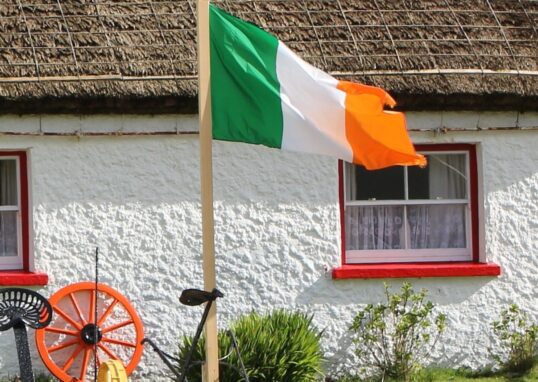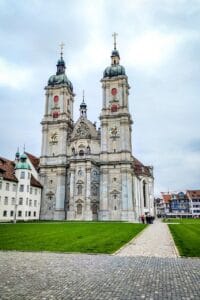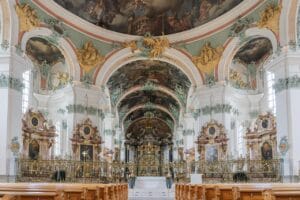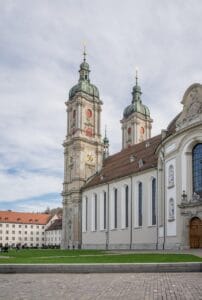Abbey of St Gall, Switzerland

Abbey of St Gall – A Timeless Treasure of Switzerland
Switzerland has mountains, lakes, and picturesque towns. But aside from its natural wonders, it also has treasures of history and culture. And one of the most significant of these is the Abbey of St Gall, found in the city of St. Gallen. The abbey is not just a building. It is a story of religion, knowledge, and power. Founded in the 8th century, it became one of the greatest monasteries in Europe. Its library is famous throughout the world, its cathedral is awesome, and its history exceeds 1,200 years. The abbey and library are now a UNESCO World Heritage Site. Visitors come to find the combination of Baroque architecture, medieval manuscripts, and tranquil environment. We will learn about the history of the abbey, its architecture, library, and importance in Europe throughout this blog. We will also look at the surrounding city of St. Gallen and surrounding attractions worth visiting.
The Origins of the Abbey
The Abbey of St Gall was founded on the name of Saint Gallus, who was an Irish monk. Around the year 612, Gallus arrived in this place on his European travels. He spent his days in simple prayer alongside the Steinach River. His simple hermitage, upon his death, became a place of pilgrimage. In 719, Saint Othmar founded a Benedictine monastery in its stead. Such was the origin of the Abbey of St Gall. In the succeeding centuries, the abbey gained more importance. It emerged as a center of spirituality, a school of learning, and a cultural influence.
Growth and Influence in the Middle Ages
In the Middle Ages, the Abbey of St Gall was one of the most influential monasteries in Europe.
- It housed several hundred monks. It was a school, with theology, music, and literature schools. It collected and copied manuscripts, preserving ancient knowledge.
The abbey’s scriptorium (writing house) earned its reputation. Monks transcribed here writings of the Bible, classical authors, and scientific texts. Without them, much of Europe’s knowledge might have been lost. The golden age of the abbey was during the 9th century when Abbot Gozbert was at its head. He stimulated the creation of the Plan of St Gall, an uncommon architectural drawing. The plan, written around 820, depicts the perfect layout of a Benedictine monastery. It is among the most important medieval texts in all of Europe.
The Abbey’s Decline and Transformation
Like most monasteries, Abbey of St Gall was not without issues. Wars, burning, and political strife eroded it over time. In the 16th century, Protestant Reformation swept through Switzerland. The city of St. Gallen became Protestant, but the abbey did not. This led to tension between the abbey and the city. In spite of trouble, the abbey survived. In the 18th century, the buildings of the abbey were re-created in a magnificent Baroque fashion. The cathedral and library of the period are what visitors visit today. Finally, in 1805, the abbey was dispersed by the Canton of St. Gallen. But its buildings, library, and legacy were preserved.
The Cathedral of St Gall
The center of the abbey compound is the Cathedral of St Gall.
Exterior
The cathedral is built in the Baroque style with two high towers and an exquisite façade. The green domes and light colors make it sophisticated in appearance.
Interior
Inside, the cathedral is breathtaking. White stucco, gold adorment, and pastel frescoes create a serene and regal atmosphere. Paintings of biblical scenes decorate the ceiling. The upper altar shines in gold and marble. The choir stalls are intricately carved. The atmosphere is both grandeur and peaceful. The cathedral is currently used as a Catholic church. It is also used for concerts, especially because of its acoustics and its historic organs.
The Abbey Library
Perhaps the most famous part of the Abbey of St Gall is its library. It is one of the world’s oldest and most beautiful libraries.
History
The library had its beginnings in the 8th century. It grew to become one of Europe’s most superior collections of manuscripts. The library today houses over 170,000 pieces, including manuscripts, early printed books, and rare documents. There are approximately 2,100 manuscripts dating from before 1000 AD.
The Hall
The 18th-century library hall is a masterpiece of Baroque design. Wooden panelling covers the walls. Rich frescoes adorn the ceiling. Dark polished wood makes up the floor. To walk through the doors is to walk into a treasure chest of knowledge.
Manuscripts
Some of the best-known items are:
- The Plan of St Gall (9th century). Early medieval music manuscripts with neumes (the earliest known musical notation). Ancient texts by writers like Virgil and Aristotle.
The door has the following inscription: “Medicina mentis” (medicine of the soul). This is an indication of how precious knowledge was for monks.
UNESCO World Heritage Status
UNESCO declared the Abbey of St Gall and its library a World Heritage Site in 1983. UNESCO designated it as a unique example of a Carolingian monastery and medieval Europe’s cultural center. The abbey contained classical and Christian books that shaped European civilization.
Life at the Abbey
The St Gall monks followed the Rule of Saint Benedict. Their life was structured around prayer, work, and study.
- They prayed numerous times each day. They worked in fields, gardens, and workshops. They studied and copied manuscripts.
The abbey itself was almost a city in miniature form. It housed kitchens, stables, guesthouses, schools, and a hospital. It allowed the abbey to thrive for centuries and be used as a model for other monasteries.
Surrounding Places to Visit in St. Gallen
As you catch sight of the Abbey of St Gall, you will also be eager to go and explore around it. The abbey is the focal point of the city, but St. Gallen itself and the surrounding region have much in store. There are cultural attractions, historic alleys, mountains, and lakes to discover.
St. Gallen Old Town
The old town of St. Gallen is walkable from the abbey. It is quaint and historic. Quaint streets and houses with brightly coloured multicoloured façades. The painted bay windows abound in most of them. The bay windows are works of art, and each one has a tale to tell. Wandering through the old town is like stepping back into history. Local artwork is available at tiny shops, and charming cafes invite you to sit down and have a cup of coffee. In the evenings, the streets are aglow with light. This makes the old town perfect for a stroll after visiting the abbey
The Textile Museum
St. Gallen has a rich textile history. In fact, it was renowned globally as a place for embroidery. The Textile Museum showcases its glorious past. You will find there ancient fabrics, lace, and fashion accessories. Some of them are centuries old, while others showcase contemporary innovation. The museum tells of how St. Gallen’s fabrics were exported to markets all over the world. It also tells of how embroidery made the city rich and known. If you are an art admirer, a history enthusiast, or a fashion aficionado, this museum is something you cannot afford to miss.
Kunstmuseum St. Gallen
For those who like art, the Kunstmuseum is also worth visiting. This is a museum that contains paintings and sculptures of various eras. You will find Middle Ages, Renaissance, and modern art works. Both Swiss and foreign artists are represented in the collection. The museum is small, so you can visit it at your own pace. It has a serene and inspiring atmosphere. Coupled with the abbey library, it shows how much culture is valued in St. Gallen.
Wildlife Park Peter and Paul
If you prefer animals and nature, visit the Wildlife Park Peter and Paul. The park is located on the top of a hill overlooking the city. Deer, ibex, wild boar, and other local wildlife live there. It is free to enter and is open all year. The park is also famous for its vistas. From the top of the hill, you have a view of St. Gallen, Lake Constance, and even the Alps if it’s a clear day. The best about this is that it is great fun for the kids and relaxing for the parents.
Lake Constance (Bodensee)
Within a day of a quick train journey of St. Gallen, Lake Constance is one of Europe’s great lakes. It shares borders with Switzerland, Germany, and Austria. Thus, three nations can be seen within a day. You can boat, swim, or bike around the shores. Romanshorn and Rorschach towns in the Swiss side are good destinations to see. The ferry also travels to Lindau in Germany or Bregenz in Austria. Lake Constance is especially beautiful in summer. The sea is blue, air is fresh, and scenery is green. It is a perfect escape from the city.
Appenzell Region
Below St. Gallen is the Appenzell region. The region is known for its countryside of hilly terrain, ornamented wooden houses, and tradition. The town of Appenzell is the center of culture. As you walk around the town, you see houses painted in bright colors and adorned with flowers and murals. Appenzell is also famous for its cheese. One can go to Appenzeller dairies and try the classic Appenzeller cheese. It has a strong smell and is typically used in Swiss dishes like fondue. The region is also perfect for trekking. Trails lead into the Alpstein mountains, where you get to breathe in fresh air and marvel at open vistas. Alpine huts and traditional farms add to the uniqueness of the treks.
Säntis Mountain
One of the most vivid mountains within striking range of St. Gallen is the Säntis. Towering at 2,502 meters, the highest of the Alpstein chain, you can ascend to the summit by cable way from Schwägalp, an hour from St. Gallen. From the peak, you can see far and broad. On a sunny day, the sight reaches six countries: Switzerland, Germany, Austria, Italy, Liechtenstein, and France. The sight is just breathtaking. Säntis is a year-round destination. In the summer, one can hike or simply enjoy the view. In the winter, the mountains are white with snow and a fairy-tale destination.
Stein am Rhein and Rhine Falls
If you drive a bit farther out, you can visit Stein am Rhein, a tiny village renowned for its tastefully painted houses. The medieval old town is one of the most charming in Switzerland. There are paintings on each house with rich colors showing historical scenes, myths, or daily life. Just a short distance from Stein am Rhein are Europe’s largest falls, the Rhine Falls. The power of water is incredible. You can stand along the falls on paths or horse boat to the rocks in the middle of the river. tein am Rhein and the Rhine Falls can be accomplished on a day trip from St. Gallen.
Zurich
Zurich, Switzerland’s largest city, takes about an hour by train. Zurich is a mix of the new and the old. There are winding streets and churches and houses that date back a long time in the old town. There are places for relaxation by the river and the lake. There are several museums, shops, and restaurants too. For visitors to St. Gallen, Zurich is a straightforward day trip. It completes your Swiss experience, from peaceful abbey to urban lifestyle.
Nearby Attractions Beyond St. Gallen
Lake Constance (Bodensee)
Just a short drive from here is the great Lake Constance, one of the largest lakes in Europe. You can boat across it, swim in its waters, or bike along its shoreline. The lake borders on Switzerland, Germany, and Austria, so visiting three countries in a day is possible.
Appenzell Region
South from here lies Appenzell, a region of rolling hills, tradition, and cheese. Hike the Alpstein mountains, taste local cheese, and view painted wooden houses.
Säntis Mountain
Säntis is the highest in the area. A cableway takes you to the top, and there you can look out over breathtaking views of six countries on clear days.
Zurich
One hour away, Zurich boasts museums, shopping, and nightlife. It’s a great option for tourists who want to combine history with modern life.
Visitor Information
- Opening Hours: The abbey library and cathedral are open most days, though they do have variable hours.
- Tickets: The cathedral is free to visit, but the library is ticketed.
- Guided Tours: Conducted in many languages, tours help the visitors understand the abbey’s rich history.
- Dress Code: The cathedral being a place of worship, modesty is advised.
Conclusion
The Abbey of St Gall is an architectural wonder and a testament to faith and learning. It started as a hermitage and evolved into a European giant, shaping history. Its cathedral sparkles with Baroque brilliance. Its library holds treasures of the mind. Its history holds the record of battle and triumph through centuries. Beyond the abbey, the town of St. Gallen and its surroundings offer charm, nature, and culture. From Constance Lake to Appenzell, the region is full of surprises. To the traveler, to visit here is more than sightseeing. It is an excursion into the heart of Europe. The St Gall Abbey is a cultural gem. But the experience is all the more charming when you explore the surrounding area. From old town to ancient times, from the tranquil Appenzell hills to Lake Constance and Säntis Mountain, the landscape is teeming with diversity. No matter what your passion for history, art, nature, or cuisine, there is something for all. Although the abbey may take you there, the areas around will make your experience unforgettable.
Author
Related posts

Ireland
Ireland – Gentle green Landscapes, A deep cultural soul Ireland is a beauty of a country, often called Emerald Isle, full of...
Read out all
Iceland
Iceland – Dramatic landscapes Iceland is among the most unique and breathtaking countries in the world. It sits in the North Atlantic...
Read out all







